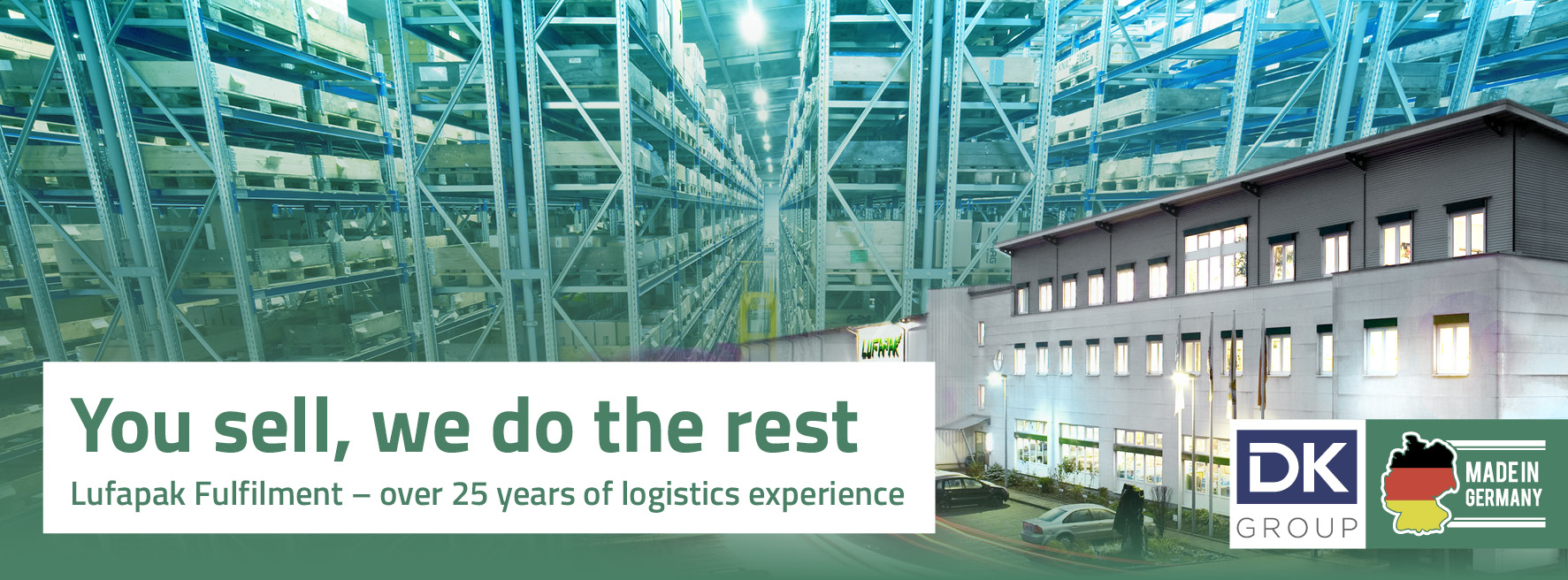sales@lufapak.de +49 2631/384-0 Contactform
Consignment warehouse
What is a consignment warehouse?
A consignment warehouse, often referred to as a consignment warehouse, is a special form of warehousing in which the goods are physically stored by the retailer or a third party, but remain the property of the supplier (consignor) until they are sold or consumed. The main feature of this warehousing concept is that the consignee (the party storing the goods) only pays for the goods when they are actually removed from the warehouse and used or resold.
This type of storage enables a close partnership between suppliers and retailers and aims to increase efficiency in the supply chain by minimizing inventory, avoiding tying up capital in unsold goods and improving responsiveness to market demand.
The operation of a consignment warehouse begins with the establishment of an agreement between the consignor and the consignee that governs the terms for storage, management and payment of the goods. The consignor delivers the products to the consignment warehouse, but retains ownership of the goods until they are sold. The consignor takes over the storage and, if necessary, the presentation of the products without initially investing capital. Only when the goods are sold is the consignee obliged to pay the consignor, which reduces the inventory and triggers invoicing.
This stock strategy is particularly popular in industries where products can quickly become obsolete or where there is high variability in demand, as it reduces the risk of overstocking for the consignor and at the same time enables the consignor to ensure a broader product presence on the market.
Consignment stock: advantages and disadvantages
Consignment warehouse advantages
The optimization of the supply chain is at the forefront of the positive considerations of a consignment warehouse. By linking the supplier more closely to the retailer, more efficient inventory management can be achieved, which leads to lower stock levels while at the same time ensuring the availability of products for the end customer. This not only reduces excess stock and the associated costs, but can also shorten delivery times and improve customer service.

Consignment warehouse disadvantages
Despite the obvious benefits, there are also challenges and potential disadvantages associated with implementing and using a consignment warehouse. The complexity of managing such a warehouse system should not be underestimated, as monitoring inventory, invoicing and tracking goods sold requires precise systems and processes. In addition, consignors bear a certain amount of risk as the products remain their property until they are sold. This means that they may have to wait longer for payment and may have to take steps to take back or otherwise dispose of products that do not sell.
Overall, consignment stock offers many opportunities to make the supply chain more efficient and, if managed correctly, can be profitable for both consignors and consignees. However, companies should carefully consider the potential drawbacks and ensure they have the systems and processes in place to successfully manage the complexity.
Consignment warehouse examples
Example 1: The automotive sector
In the automotive industry, the use of consignment warehouses is widespread to ensure an efficient supply of car parts. For example, a car manufacturer might have an agreement with suppliers of special components to store them in a nearby consignment warehouse. This agreement allows the manufacturer to have immediate access to parts when needed without having to keep large quantities in stock. This not only reduces storage costs, but also shortens production cycles as the required parts are available without delay.
Example 2: Retail and fashion
In retail, especially fashion, trends can change quickly, which requires flexible inventory management. A fashion house can enter into consignment agreements with several designers so that new collections are placed directly in the store without the retailer having to buy them in advance. This allows the retailer to offer a wide range and respond quickly to changing customer preferences. Unsold merchandise can be returned to the designer after a certain period of time, minimizing the risk for the retailer.
Example 3: Healthcare
Hospitals and medical centers often work with consignment warehouses to ensure constant access to critical medical products and equipment without having to provide extensive upfront financing. For example, a medical equipment supplier might provide high-value surgical instruments or specialized medical equipment in a consignment stock within the hospital. These are only invoiced when they are actually used, allowing the hospital to maintain state-of-the-art equipment without impacting the budget.
Example 4: Construction
In the construction industry, consignment stock can be used to optimize the availability of construction materials and equipment. A construction company can make an agreement with a supplier to store important building materials in a consignment warehouse on the construction site. This ensures that materials are available quickly when they are needed and reduces downtime. This method can also avoid overstocking, as payment is only made for the materials that are actually used.
Consignment warehouse invoicing
Invoicing in the consignment warehouse follows a special process that differs from traditional purchasing transactions. The core of this process lies in the unique ownership and payment structure of a consignment transaction. Unlike traditional warehousing and sales systems where payment is made immediately after the purchase or delivery of goods, consignment warehouses often delay payment until the goods are actually sold to the end customer.
Unique invoicing processes
Sales reporting: The consignee is usually required to provide regular reports on the sales status of the consignment goods. These reports serve as the basis for invoicing, as they record exactly which items have been sold and therefore need to be paid for.
Triggering invoicing: As soon as a product is sold from consignment stock, an invoicing process is usually triggered automatically. The specific terms, such as timeframes and discounts, are often defined in the original consignment agreement.
Time delay between delivery and payment: A major challenge with invoicing in consignment stock is the time delay between delivery of the goods to the consignee and the time of payment. This can lead to liquidity bottlenecks for the consignee, as the capital is tied up until the sale takes place.
Challenges with invoicing
Managing consignment inventory: Close monitoring and management of consignment inventory is critical to ensure that all items sold are invoiced correctly. Errors or discrepancies can lead to financial losses.
Communication and transparency: Close communication between consignors and consignees is essential to ensure a smooth invoicing process. Both parties must agree on transparent reporting and timely updates on inventory and sales status.
Adapting to sales cycles: Companies may need to adapt their invoicing and accounting practices to the specific sales cycles of their consignment goods. This can be especially challenging for seasonal products or in industries with long sales cycles.
Despite these challenges, the consignment stock model offers significant benefits by enabling companies to make their warehousing and inventory management more efficient. By implementing clear agreements, precise inventory management systems and open communication channels, most consignment stock invoicing challenges can be successfully overcome.
Conclusion
Consignment warehouses offer a flexible and often cost-effective way for companies to optimize their warehousing and inventory management. By setting up a consignment warehouse, companies can benefit from improved liquidity conditions, reduce storage costs and promote closer cooperation with their partners. The benefits range from more efficient supply chain management and a more flexible response to market demand to minimizing the risk of overstocking.
At the same time, the challenges should not be underestimated. Managing a consignment warehouse requires precise coordination processes and clear communication between all parties involved. The complexity of inventory monitoring and invoicing as well as the potential liquidity risk for the consignor are factors that need to be carefully considered. In addition, the successful implementation of a consignment model requires a high level of trust and transparency between consignors and consignees.
Companies considering setting up or using a consignment warehouse should thoroughly examine the specific requirements and conditions of their business model. A detailed analysis of the benefits and potential challenges is crucial to ensure that this warehouse strategy achieves the intended goals and contributes to overall supply chain efficiencies.
The decision to use a consignment warehouse should therefore not be taken lightly. Instead, it is advisable to develop a strategy that supports both the operational and financial goals of the company, based on a sound assessment of benefits and risks. With the right planning and implementation, a consignment warehouse can become a valuable tool for agile and cost-effective warehousing and inventory management.
Contact us now and get advice

